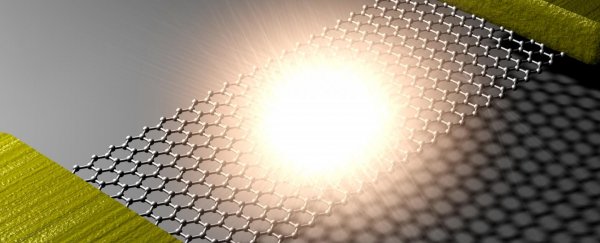For the first time ever, researchers have managed to produce visible light using graphene as a filament, creating the world's tiniest light bulb.
Researchers have been struggling for decades to produce a light source small enough to fit on a silicon chip as it will help them to create super-fast computers that process light instead of electricity - and now they've shown that wonder-material graphene, which also happens to be incredibly thin, light and flexible, can do just that.
"We've created what is essentially the world's thinnest light bulb,' one of the research leaders, James Hone, from Columbia University in the US, said in a press release. "This new type of 'broadband' light emitter can be integrated into chips and will pave the way towards the realisation of atomically thin, flexible, and transparent displays, and graphene-based on-chip optical communications."
Hone's team, which worked alongside researchers from South Korea, created the chip by attaching tiny metal electrodes to one-atom-thick strips of graphene, which were suspended on a silicon chip. These electrodes then heated the graphene up to 2,500 degrees Celsius, bright enough to produce light so bright that it could be seen with the naked eye despite its tiny size.
Researchers have struggled to create these tiny light bulbs in the past because other materials are this temperature conduct too much heat, and damage the metal wires and the rest of the chip.
But among its many useful properties, graphene actually becomes a poorer conductor of heat the hotter it gets, which means that despite its incredibly high temperatures, the heat stays in a central 'hot spot' along the suspended graphene strip, without damaging the rest of the chip.
"These unique thermal properties allow us to heat the suspended graphene up to half of temperature of the Sun, and improve efficiency 1,000 times, as compared to graphene on a solid substrate," explained one of the team members, Myung-Ho Bae.
The team also showed that the wavelengths of light produced varied depending on how far the graphene was placed from the silicon, which means that they can 'tune' the light and expand its bandwidth.
"This is only possible because graphene is transparent, unlike any conventional filament, and allows us to tune the emission spectrum by changing the distance to the substrate," said lead researcher Young Duck Kim.
The results have been published in Nature Nanotechnology, and the team is now trying to find out more about the specific properties of their graphene light source, so that they can begin to use it in optical communication devices, as well as other cool technology.
"We are just starting to dream about other uses for these structures, for example as micro-hotplates that can be heated to thousands of degrees in a fraction of second to study high-temperature chemical reactions or catalysis," said Hone.

